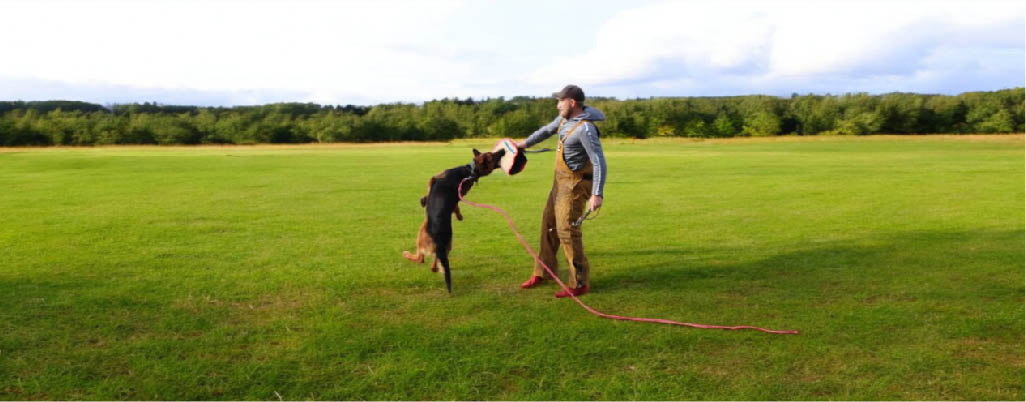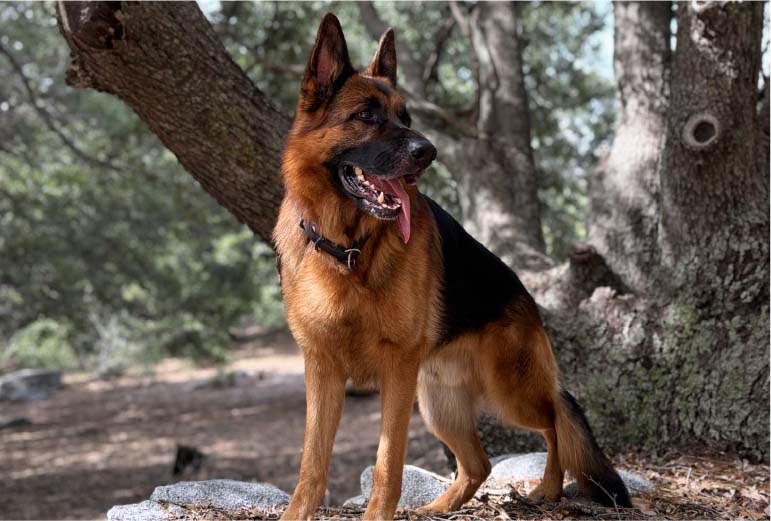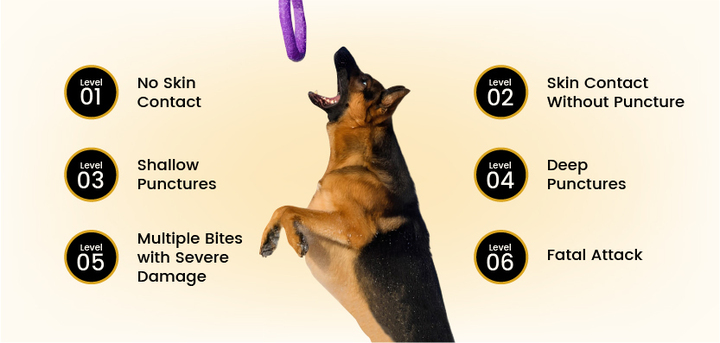
Kempkes Executive K9
German Shepherds are strong, smart, and incredibly loyal, known as one the most loved breeds in the world. Besides this, one more physical trait that really sets them apart is their bite force. With a bite pressure of around 238 PSI (pounds per square inch), these dogs have one of the strongest bites. That is a big reason why they are considered more effective in police work, the military, and as top-tier protection dogs.
However, what determines their bite being so strong? Factors like powerful jaw muscles, head structure, and instincts all contribute to the power of their bite. And if you are wondering how experts measure it, it’s not as simple as just letting a dog chomp down on something. They use specialized tools, like pressure sensors and bite sleeves, to get accurate readings.
Knowing about a German Shepherd’s bite force is important for training, handling, and keeping both the dog and those around them safe. Let’s discuss this in detail!
SUMMARY
- German Shepherds have a bite force between 238 and 300 PSI. Experts measure this using digital bite force meters in controlled tests.
- The bite force is measured using special devices with pressure transducers. They turn the force from a bite into a digital readout in PSI.
- Bite force varies across different German Shepherd lines( working, show, American, Czech) due to selective breeding for performance versus appearance.
- Safety and training protocols are crucial to managing a German Shepherd’s powerful bite. Kempkes Executive K9s has strict measures in place to maintain control while using the dog’s strength effectively.
What is GSD Bite Force?

Kempkes Executive K9
First, let’s understand what bite force means.
“It is the pressure a German Shepherd applies when biting down. This force is measured in PSI (pounds per square inch) or kg/cm² (kilograms per square centimeter) and shows how much pressure is put on a one-square-inch area while biting.”
The biting force quotient (BFQ) is a numerical statistic that represents an animal’s bite force when corrected for body mass. A stronger bite gives the animal more crushing strength, which enables it to rend flesh, break bones, and hold onto objects firmly.
Dog biting force varies by breed and is impacted by muscular development, skull shape, and jaw form. Because of their ancestry and training, some dogs, such as German Shepherds, have a larger bite force.
How is German Shepherd Bite Force Measured?
It takes special tools and careful study to measure a GSD’s bite force. Dogs don’t always bite with full strength unless they feel threatened or trained for it. Researchers use different ways to get accurate results, and the most commonly used techniques include digital bite force meters, comparative studies, and real-world testing. Each method provides insights into the strength and mechanics of a dog’s bite.
1. Digital Bite Force Meters
A digital bite force meter gives the most accurate reading of a dog’s bite strength. It has pressure-sensitive plates or bars that the dog bites. Sensors capture the highest force applied and show it in PSI or kg/cm² (kilograms per square centimeter).
How do Digital Bite Force Meters work?
- A pressure-sensitive material is covered with a protective layer.
- The dog is encouraged to bite on the device.
- The sensors detect and measure the force applied.
- The reading is displayed on a digital screen.
Dog experts, trainers, and police teams use these tools to measure bite force. They check how strong working dogs, such as German Shepherds, are.
2. Biomechanical Modeling and Anatomical Analysis
While digital bite force meters provide direct measurements, some methods rely on anatomical and biomechanical studies to estimate bite force. These studies involve:
- Skull and Jaw Analysis: Vets use X-rays or CT scans to check the shape of a dog’s skull and how its jaw is built.
- Muscle Strength and Function: Experts study where muscles attach and how they work. They look at key muscles like the masseter, temporalis, and pterygoid. This helps them understand how much force the jaw can produce.
3. Real-World Testing
Real-world testing involves assessing bite force indirectly by observing how a dog interacts with various materials under controlled conditions. For example:
- Training Exercises: During training, a German Shepherd may be asked to bite objects of known resistance, such as specially designed bite sleeves with embedded sensors.
- Material Resistance Tests: The dog’s ability to compress or tear through certain materials (e.g., durable rubber) can give an approximation of the force applied.
How does It work for Owners?
- Safety First: These tests should be carried out with proper safety protocols to prevent injury.
- Behavioral Context: Such tests are generally part of a broader training regimen that focuses on bite inhibition and controlled biting behavior.
- Data Recording: While not as precise as digital measurements, consistent observation and recording of the dog’s performance during these tests can provide insight into its bite force trends over time.
Challenges in Measuring Dog Bite Force
Measuring bite force is not always straightforward due to several challenges:
- Dogs rarely bite at full strength unless necessary -They usually bite only as hard as needed for a given situation.
- Variation among individual dogs – Bite force can differ based on a dog’s age, size, health, and training.
- Difficulty in getting a dog to bite a measuring device naturally – Some dogs may not engage fully with bite force meters.
Despite these challenges, the methods mentioned above help scientists estimate and compare bite force across different breeds.
German Shepherd Bite Force in KG
A German Shepherd’s bite force measures between 108 and 136 kg/cm². That’s over 100 kilograms of pressure on each square centimeter when it bites with full strength.
It may not have the strongest bite, but its intelligence and control make up for it. With proper training, it becomes a powerful asset in protection and law enforcement.
How Hard Does a German Shepherd Bite?
A German Shepherd can bite with a force between 238 and 300 pounds per square inch. This strength allows them to break bones, tear through flesh, and inflict severe injuries if not managed. Their strong jaws and sharp instincts make them highly suitable for police work, search and rescue, military roles, and personal protection.
What Does PSI Mean in a Dog’s Bite?
PSI measures the pressure applied per square inch. A higher number means more force when biting down.
To understand the strength of a German Shepherd’s bite:
- It can crush bones and tear through thick materials.
- Their jaws snap shut with immense power in an instant, making their bite dangerous in defense or attack.
- Once they lock onto something, their grip stays firm, making it hard to escape.
What Factors Determine How Strong a Dog’s Bite Force is?

Kempkes Executive K9
Many factors, including anatomy, physiology, and behavior, influence a dog’s bite strength. Every dog has the potential to bite. However, the force of their bite can differ significantly. This is due to variations in body size, jaw muscles, bite mechanics, and skull structure.
1. Jaw Structure & Skull Shape
The shape and structure of a dog’s skull and jaw significantly influence its bite force. German Shepherds have a mesocephalic skull, which means their muzzle is of average length and width, not too short like some dogs or too long like others. This balanced structure allows for optimal leverage and force distribution when biting. This balanced structure allows for optimal leverage and force distribution when biting.
Key Structural Aspects That Influence Bite Force
- Mandibular Leverage: The shape and size of the lower jaw (mandible) affect how well the muscles transfer force to the teeth. German Shepherds have a longer mandible, giving them more bite reach and stronger pressure.
- Zygomatic Arch (Cheekbone): This is where the jaw muscles attach. A well-developed zygomatic arch provides a strong anchor for the masseter and temporalis muscles, both critical for bite force.
- Rostral Strength: The front of the skull, including the maxilla (upper jaw), contributes to the dog’s ability to grip and hold onto objects with power.
2. Muscle Mass & Jaw Strength
The muscles powering the jaw play a crucial role in determining how hard a German Shepherd can bite. There are three primary muscles responsible for jaw movement and bite force:
Key Jaw Muscles in Bite Force Production
- Masseter Muscle: The largest and most powerful jaw muscle, responsible for clamping and crushing force.
- Temporalis Muscle: Controls the upward force of the bite and helps maintain prolonged pressure.
- Pterygoid Muscles: Aid in side-to-side jaw motion, increasing grip efficiency.
German Shepherds have well-developed masseter and temporalis muscles, allowing them to generate high clamping pressure while maintaining a strong grip on their target.
3. Size & Weight
A dog’s overall size and body mass directly impact its bite force. Larger dogs typically have:
- More muscle mass for generating force.
- Larger jaws for better leverage.
- Higher overall strength, allowing them to exert more pressure when biting.
The average adult German Shepherd weighs between 65–90 lbs (30–40 kg) and stands about 22–26 inches (55–65 cm) tall at the shoulder. Their powerful frame and robust musculature contribute to their ability to exert significant bite pressure.
4. Bite Technique
Bite technique plays a vital role in how force is applied. Dogs bite differently. Some snap quickly, while others clamp down and hold. German Shepherds are known for their full-mouth bite technique, which enhances their effectiveness in protection work and law enforcement.
Types of Biting Techniques & Their Impact on Force
- Scissor Bite (Shearing Action): Used when the dog applies force while shifting its jaw, creating a cutting effect.
- Crushing Bite: Applied with full pressure, often used to immobilize or break objects.
- Sustained Grip (Clamping and Holding): A hallmark of police and military German Shepherds, where they bite and maintain pressure on a suspect or object until given a release command.
A trained German Shepherd is taught to bite with maximum efficiency, making their bite far more effective than an untrained dog with the same bite force.
5. Training & Temperament
Training and temperament determine how and when a German Shepherd uses its bite force. Proper training ensures that the dog learns to control bite intensity, while an untrained or aggressive dog may apply full force unpredictably.
Factors That Influence Bite Force Through Training & Behavior
- Controlled vs Uncontrolled Biting: A trained German Shepherd can adjust bite pressure based on commands. For example, police dogs are trained to bite firmly but not lethally unless in extreme situations.
- Prey Drive & Defense Drive: High prey drive (instinct to chase and catch) and defense drive (instinct to protect) affect bite strength and intent. A dog biting in a defensive state often exerts more pressure than one engaging in a controlled bite exercise.
- Bite Inhibition: Puppies naturally learn bite inhibition from their littermates. Proper training further refines their ability to regulate bite force when interacting with humans.
The 6 Levels of a German Shepherd Dog Bite

Dr. Ian Dunbar’s Dog Bite Scale is commonly used to study dog behavior. It explains these six levels in detail. Here’s a simple breakdown of each level and what it means.
Level 1: No Skin Contact
This type of bite involves mouthing, nipping, or snapping without making contact with the skin. It is common in puppies during play and in adult dogs to show frustration or warning signals rather than aggression. No physical harm occurs, but frequent Level 1 bite can indicate stress, overstimulation, or lack of bite inhibition training.
A Level 1 bite is a pre-bite threat display, often accompanied by growling, bared teeth, and stiff body posture. Dogs use this level of biting as a non-contact deterrent to avoid escalating aggression.
Level 2: Skin Contact Without Puncture
At this stage, the dog’s teeth make contact with the skin but do not break it. The pressure is controlled, and the bite may cause redness or minor bruising. This level is often seen in excited play, mild warning bites, or accidental bites during training or handling.
- A Level 2 bite exerts low PSI (pounds per square inch) pressure, meaning the jaw muscles engage minimally.
- The dog uses its bite inhibition reflex, a learned behavior that prevents excessive force.
- Common causes include overstimulation, frustration, or learned behavior from improper socialization.
Level 3: Shallow Punctures
A Level 3 bite causes one to four shallow punctures, each less than half the length of the dog’s canine teeth. This occurs when the dog bites with moderate force, often due to fear, stress, or territorial behavior. The bite may be accompanied by snarling, lunging, or snapping.
- At Level 3, the masseter and temporalis muscles engage more forcefully, leading to penetration of the skin.
- Canine teeth, which are conical and designed for gripping and tearing, exert enough localized pressure to break the skin.
- A bite force measurement at this level may range between 100–200 PSI, depending on the dog’s intent and strength.
Level 4: Deep Punctures
This level involves one or more deep puncture wounds exceeding half the length of the dog’s canine teeth. The bite exerts full pressure, often resulting in bruising, tearing, or tissue damage. A Level 4 bite is considered serious and indicates a lack of bite control or a defensive, aggressive response.
- Level 4 bites involve high bite force application, potentially exceeding 200–250 PSI in German Shepherds.
- The dog clamps down and applies crushing pressure, leading to deep tissue trauma.
- The risk of infection is significantly higher due to bacteria entering deep wounds.
- The behavior is often triggered by extreme stress, resource guarding, or predatory instincts.
Level 5: Multiple Bites with Severe Damage
At this level, the dog bites multiple times, causing severe punctures, lacerations, or avulsions (skin tearing away from muscle tissue). The attack is sustained and repeated, often requiring medical intervention. Level 5 bites are usually seen in highly aggressive, fearful, or reactive dogs that perceive a severe threat.
- At Level 5, the dog bites with full commitment and may enter a predatory or defensive attack mode.
- The pterygoid muscles engage to increase jaw stability, allowing the dog to hold and tear at its target.
- The bite force may reach the German Shepherd’s peak capacity of 238–300 PSI, causing deep penetration and crush injuries.
- This behavior is often triggered by strong predatory instincts, extreme fear, or improperly trained attack responses.
Level 6: Fatal Attack
A Level 6 bite results in the death of the victim, whether human or animal. This level of aggression is rare but occurs in cases of severe territorial aggression, predatory attacks, or uncontrolled attack behavior. Dogs displaying Level 6 bites are often deemed dangerous and require immediate intervention from professionals.
- Level 6 bites go beyond control or restraint, with the dog delivering maximum sustained force until the victim is incapacitated.
- The mandibular closing force is maximized, using all jaw muscles in unison.
- The dog may lock onto the victim (though German Shepherds do not have a physical locking mechanism like Pit Bulls).
- This level is often seen in extreme predatory responses or rage syndrome cases.
How German Shepherds Use Their Bite Force?
German Shepherds use their strong bite force in a controlled way for different tasks. Their training, anatomical build, and behavior allow them to use their bite power safely in work settings. Below are detailed descriptions, followed by key points about how they operate.
1. Law Enforcement & Military
German Shepherds are extensively trained to apply a controlled bite force during apprehension tasks. They use a “bite and hold” technique to detain suspects, ensuring immobilization while maintaining command control through rigorous operant conditioning protocols.
- Controlled Bite Engagement: Utilizes specific training protocols for bite initiation and release. The bite force is applied in a “squeeze hold” technique that maximizes pressure in a confined area.
- Operant Conditioning: Dogs are conditioned to respond to release commands via positive reinforcement. Consistent training ensures repeatable, reliable responses during high-pressure situations.
- Mechanical Leverage: The skull’s design and jaw structure allow for optimal force transmission and controlled clamping pressure. Coordination between the masseter and temporalis muscles is critical for delivering the precise force needed.
2. Personal Protection
In personal protection scenarios, German Shepherds are trained to modulate their bite force for defensive purposes. They are conditioned to bite and then immediately release on command, ensuring the protection of their handler without causing excessive injury.
- Bite Modulation Training: Emphasis on “bite inhibition” techniques to regulate applied force. Use of specific verbal cues or hand signals to trigger immediate bite release.
- Neuromuscular Control: Coordination of jaw muscles (masseter, temporalis, pterygoid) for a precise, controlled bite. Training involves repeated drills with force measurement devices to ensure consistent performance.
- Tactical Application: Bite is applied in strategic areas to immobilize without lethal damage. Employed in scenarios that require rapid decision-making and controlled physical responses.
3. Herding & Livestock Work
When working with livestock, German Shepherds apply a gentle yet effective bite force to guide and manage animal movement. Their training emphasizes low-pressure biting to serve as tactile cues, ensuring that the animals are directed without causing injury. If offers
- Sub-Maximal Force Application: Bite force is carefully modulated to remain below injurious thresholds. Applied pressure is sufficient to signal direction changes without breaking skin integrity.
- Precision and Timing: The controlled bite is delivered at specific body points, such as the hindquarters or flank, to gently nudge livestock. Training involves repetitive conditioning to ensure accurate force delivery and timing.
- Fine Motor Control: Development of precise jaw muscle coordination through targeted exercises during early training phases. Use of sensor-based evaluations during training to monitor and adjust the force output.
4. Defense Mechanism
German Shepherds naturally deploy their bite force as a rapid defensive response when encountering a direct threat. This instinctual behavior is underpinned by neurological reflexes and muscle activation patterns that allow the dog to quickly clamp down and immobilize a threat.
- Instinctual Reflexes: Activation of neural pathways, including brainstem reflex arcs, leads to immediate, forceful jaw closure. Adrenaline and heightened situational awareness enhance the bite’s force and response speed.
- Rapid Muscle Recruitment: Quick engagement of the masseter, temporalis, and pterygoid muscles ensures a high PSI bite force when needed. Coordination between sensory input and motor output minimizes reaction time.
- Controlled Aggression: Even in a defensive state, training emphasizes controlled force application to avoid collateral damage. Defensive bites are typically followed by rapid disengagement upon the cessation of threat signals, facilitated by prior training in bite inhibition.
Do All German Shepherds Have the Same Bite Force?
Not every German Shepherd has the same bite force. It usually falls between 238-300 PSI. Several things affect it, like genetics, age, size, jaw structure, and muscle strength. These factors create slight differences in how strong each dog’s bite is.
This table shows different types of German Shepherds and their estimated bite forces in PSI. It also covers the factors that affect these numbers.
| German Shepherd Type | Average Bite Force (PSI) | Characteristics / Influencing Factors |
|---|---|---|
| West German Working Line | 280–300 PSI | These dogs have robust musculoskeletal development, high drive, and enhanced jaw muscle strength, resulting in maximum bite force. |
| European German Shepherd | 260–290 PSI | A balanced combination of working ability and temperament, robust structure, and sound muscular development yield a reliable, moderate bite force. |
| West German Show Line | 238–260 PSI | They emphasize visual standards and controlled behavior, with slightly lower physical performance and bite force compared to working lines. |
| American German Shepherd | 250–280 PSI | These dogs display balanced physicality and moderate to strong bite force, making them versatile for protection and companion roles. |
| Czech German Shepherd | 270–300 PSI | Due to their high performance, they contribute to a powerful bite force through increased muscle density. |
| East German Working Line (DDR) | 265–305 PSI | Have slightly higher bite force due to selective breeding. |
Do German Shepherds Have the Strongest Bite Force?
German Shepherds have a strong bite force, but research shows they don’t have the strongest bite among all dog breeds.
Below is a detailed comparison of the German Shepherd’s bite force, based on studies and anatomical data, alongside other breeds.
| Different Breeds | German Shepherd (Alsatian) | Rottweiler | Belgian Malinois | American Pit Bull Terrier | Kangal | English Mastiff | Doberman Pinscher | American Bulldog |
|---|---|---|---|---|---|---|---|---|
| Average Bite Force (PSI) | 238 – 300 PSI | ~328 PSI | ~220 – 250 PSI (estimated) | ~235 PSI | ~743 PSI | Wake Up and Potty Break | ~552 PSI (approx.) | ~305 PSI (approx.) |
This table shows that raw PSI is a key metric. However, in real-life situations, the success of a bite depends on more than just PSI. It also relies on control, accuracy, and training that suits each breed’s particular job.
Safety Precautions for Dealing With German Shepherds Bite
Owners, trainers, and handlers must use the right safety steps to avoid accidents. A careful approach helps people and dogs interact better. The guidelines below include proven training methods, canine behavior science, and risk management tips.
1. Comprehensive Behavioral Assessment and Training
Conduct standardized evaluations (e.g., C-BARQ) to monitor stress indicators like cortisol and heart rate. Employ operant conditioning with positive reinforcement and bite inhibition training using digital bite force meters. Certified behaviorists should regularly assess performance.
2. Personal Protective Equipment (PPE) for Handlers
Wear strong gloves that resist bites. Use reinforced sleeves for extra protection. Choose bite sleeves made from tough fibers that absorb impact. Secure physical barriers in training areas to minimize accidental contact.
3. Muzzle Training and Usage
Select performance-engineered, open-design muzzles that allow normal respiration while restricting full-force bites. Gradually acclimate dogs to muzzles, monitoring stress markers to ensure a positive association.
4. Environmental Management and Control
Design training areas with non-slip flooring, defined boundaries, and calming auditory/visual cues. Conduct routine safety audits to verify that enclosures and structural modifications meet technical standards.
5. Emergency Protocols and First Aid Training
Develop comprehensive emergency response plans with canine-specific first aid kits. Train handlers in advanced first aid techniques and establish rapid access to veterinary services.
6. Handler Education and Certification
Mandate-certified courses in canine behavior management, bite inhibition, and emergency protocols with regular refresher training and detailed record-keeping.
Adhering to these technical measures minimizes risks associated with a 238–300 PSI bite force, ensuring controlled, safe interactions.
FAQs
Why Does My German Shepherd Bite Himself?
A German Shepherd might bite itself for different reasons. Itchy skin from allergies, fleas, or infections can be a cause. Stress, anxiety, or boredom could also lead to this behavior. If it keeps happening, a vet should check for health problems or behavioral issues. The right treatment or training can help.
Do German Shepherds Lock Jaw?
No, German Shepherds do not possess the ability to “lock” their jaws. This is a myth often associated with certain breeds. While their bite force is strong, their jaws do not physically lock in place. Instead, they have well-developed jaw muscles for a secure grip, which can be released on command with proper training. for 8 seconds
The Bottom Line
The bite strength of German Shepherds not only just makes them excellent working dogs in law enforcement, military, and protection roles but also highlights the importance of proper training and socialization for them. A well-trained German Shepherd will be a loyal and loving companion, capable of using its strength responsibly.
At Kempkes Executive K9s, we specialize in world-class German Shepherds bred for temperament, intelligence, and protection. We provide expertly trained dogs raised to be both loving family members and highly capable working dogs. If you are looking for the best in German Shepherd breeding and training, contact us at (661)-904-4737 now!





